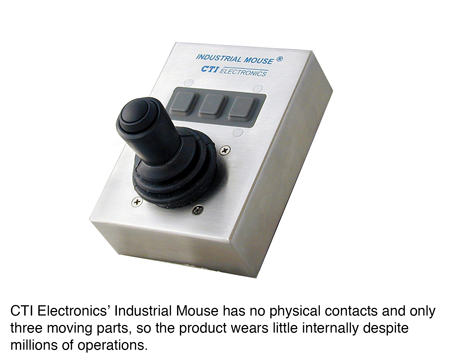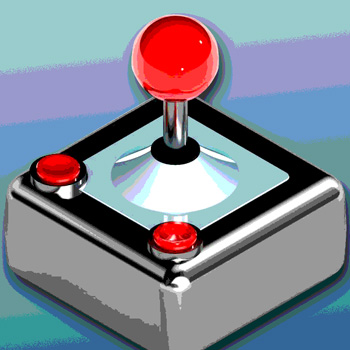Industrial peripherals—joysticks, mouse pointers and keyboards that serve as the interface between man and processing equipment—are under constant assault in harsh, messy industrial environments.
In processing plants, mines, mills and manufacturing environments across the country, these peripherals are exposed to extreme high and low temperatures, moisture, high-pressure wash downs, dirt, grime and operator abuse often around the clock.
Unfortunately, many of the so-called “industrial” peripherals that claim to be built to last in these environments often fail or malfunction within months and need to be replaced or repaired at considerable ongoing cost.
The problem, it turns out, is not the harsh, abusive environment. Instead, many industrial peripheral manufacturers rely too heavily on ruggedized enclosures, while utilizing commercial-grade components and internal designs adopted from the personal computer market.
Built to meet established industry standards, many so-called industrial peripherals are protected by a NEMA 4X (IP66) enclosure. This designation indicates the enclosure will protect internal components from dust, dirt, water (including pressure washing) and even external formation of ice.
In addition to the enclosure, the industry shares many other common techniques to keep peripherals sealed and watertight. Industrial keyboards, for example, are commonly covered with monolithic elastomer covers.
But like the old saying goes, you can’t judge a peripheral by its cover or its enclosure. A deeper look into the internal components and design separates the “industrial” peripheral from those truly ruggedized devices that survive—and thrive—for many years.
In the spirit of true industrial engineering, this means ruggedized industrial-grade components that can stand up to -40 °C to 80 °C, are hardened against wear caused by heavy or rough use, and designed with less moving parts and less potential points of failure.
For Robert Johnson, a service technician for Minteq (www.minteq.com), a company that supplies products for steel foundries, the environment is, “among the harshest imaginable” and the choice of peripheral for the control system was extremely critical.
The product Johnson services is Minteq’s LaCam laser profile measuring units for non-contact measurement of refractory linings in metallurgical reaction and transport vessels. The equipment is operated in an environment where temperatures can vary from -10 °F to over 2,000 °F at the furnace.
“We were using an industrial keyboard/mouse combination unit,” explains Johnson. “But it was not very reliable. It wasn’t very industrial. It didn’t react to the temperature extremes like we needed. It would lock up from time to time. We were constantly replacing them.”
There were other problems as well. The keyboard/mouse combination also came with a guide rail and roller system to pull the keyboard out during use that wasn’t properly designed to handle dirt or the extreme high and low temperatures.
The mouse component of the unit also would not respond well when operators were wearing gloves, which in the steel industry is most of the time. Finally, once the membrane that covered the mouse got dirty or a little bit roughed up it would not work well. Because it was a combo, when the mouse began to fail the entire unit had to be replaced.
Johnson estimates this occurred every couple of months over the span of 10 years.
Eager for a better solution, Johnson literally spent several years searching for an alternative. He estimates he tried 6–7 different products before discovering the Industrial Mouse® from CTI Electronics.
 CTI Electronics (Stratford, Connecticut) designs and manufactures industrial-grade trackballs, joysticks, keyboards, and intelligent switches for OEMs, system integrators and commercial end users.
CTI Electronics (Stratford, Connecticut) designs and manufactures industrial-grade trackballs, joysticks, keyboards, and intelligent switches for OEMs, system integrators and commercial end users.
The Industrial Mouse is a rugged joystick used as a mouse-pointing device. The product is designed using an inductive effect patented by CTI Electronics to deliver the desired control. Unlike the most joystick style devices, there are no physical contacts and only three moving parts, so the product wears little internally despite millions of operations.
For Johnson test driving the Industrial Mouse was a no-risk proposition. CTI Electronics offers a free 15-day trial of its pointers or keyboards to any potential customer that wants to experience the product in operation in a side-by-side comparison with an existing peripheral.
“It’s the easiest thing to install, you basically plug it in and it works,” explains Johnson. “There’s no fooling around with it—no drivers, no settings, no nothing.
Today, the devices Johnson installed 1½ years ago are still in service today.
“The most impressive thing is it’s almost indestructible,” says Johnson. “It handles everything we throw at it from the extreme heat down south to extreme cold up at the top of Lake Superior. Sometimes, you’ve got to go from the furnace with the 2,000 to 2,400 degrees back to -10 degrees in about a minute. It handles all that without skipping a beat.”
“The operators love it,” adds Johnson. “It’s a joystick and they can use it while wearing gloves. It’s got a little button on top. Basically, it’s like a video game to them. It’s easy and fast. They can just move, click, move, click, move, click.”
The adoption of the Industrial Mouse has allowed Minteq to eliminate the keyboard component altogether. Now operators utilize the joystick along with touch screens.
Eliminating the keyboard also put an end to the difficulties with the guide rail and roller mechanism and bought them about a 1¼” of additional room inside the machine for future design elements, says Johnson.
“It’s been a complete win,” reports Johnson. “We’ve upgraded every keyboard/mouse unit that failed or that we simply wanted to upgrade.”
For more information, contact CTI Electronics Corporation at 203.386.9779; sales@ctielectronics.com or visit www.ctielectronics.com.
True Industrial-Grade Peripherals: Much More than Just a NEMA Enclosure




